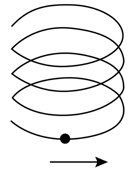H C Verma Solutions for Chapter: Circular Motion, Exercise 3: OBJECTIVE II
H C Verma Physics Solutions for Exercise - H C Verma Solutions for Chapter: Circular Motion, Exercise 3: OBJECTIVE II
Attempt the practice questions on Chapter 7: Circular Motion, Exercise 3: OBJECTIVE II with hints and solutions to strengthen your understanding. CONCEPTS OF PHYSICS [VOLUME 1] solutions are prepared by Experienced Embibe Experts.
Questions from H C Verma Solutions for Chapter: Circular Motion, Exercise 3: OBJECTIVE II with Hints & Solutions
An object follows a curved path. The following quantities may remain constant during the motion.
Assume that the Earth goes around the Sun in a circular orbit with a constant speed of .
The position vector of a particle in a circular motion about the origin sweeps out equal area in equal time. Its
A particle is going in a spiral path, as shown in figure with constant speed.

A car of mass is moving on a horizontal circular path of the radius . At an instant, its speed is and is increasing at a rate . Then
A circular road of radius is banked for a speed A car of mass attempts to go on the circular road. The friction coefficient between the tyre and the road is negligible.
A person applies a constant force on a particle of mass and finds that the particle moves in a circle of a radius with a uniform speed , as seen from an inertial frame of reference.
